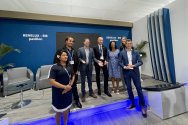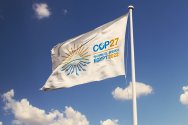
News
Student at COP27: ‘Invest in young people’
World leaders, NGOs and scientists are meeting this month in Sharm-el-Sheikh, Egypt at the UN climate conference COP27. WUR student Thomas Westhoff is there.
Why are you at the climate summit?
‘IAAS went to Glasgow last year, our first climate summit in years. Many valuable contacts came out of that, including a partnership with FAO (the United Nations Food and Agriculture Organization.). In the runup to the current summit in Egypt, we organized conferences at which young people formulated policy recommendations. That’s quite tricky, because what seems like a good idea to a European might be a bad idea to an African. For us it’s a way of seeking consensus as a kind of youth UN: we ask, “What would benefit everyone?”’
‘Also, IAAS members around the world are setting up climate-adaptive agriculture projects. I am going to the COP to find investors for those projects and to increase the visibility of IAAS.’
What message are you taking with you?
‘That young people should play a leading role in shaping the future. That message is being received positively, as you can see from the increasing number of partners who want to work with us. For example, the FAO is making budgets and training courses available for things like learning how to write proposals for development organizations and banks. With such training, more young people can approach development banks with agricultural projects, which makes the banks more aware that they should be involving young people in such things. That’s the development that I want to highlight: the involvement of young people in shaping a better future. There is a generation of young people champing at the bit, eager to initiate change. Invest in that.’
‘I also have a letter with me inviting Frans Timmermans and Mark Rutte for a dialogue with students at the IAAS congress in January, when students from all over the world will come to Wageningen. And at the conference, we also want to present and discuss the results of a new policy paper.’
How is IAAS different from climate action groups?
‘We have the same goal but we use different means. As IAAS, we try to improve the world through political engagement and dialogue. I see a lot of pessimism, but I continue to believe in these kinds of bodies. For a global problem, it is good to establish global agreements. At the same time, we agree with activists that it’s all got to happen much faster. Countries should feel genuinely obligated to meet their climate targets.’
What would make this COP a success?
‘If it leads to firmer climate ambitions and member states involving their young people more. The targets have got to be more ambitious, they’ve got to be binding, and they’ve got to be acted upon.’




